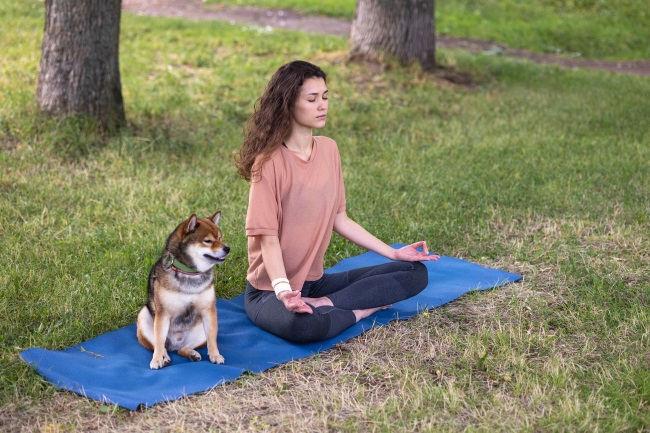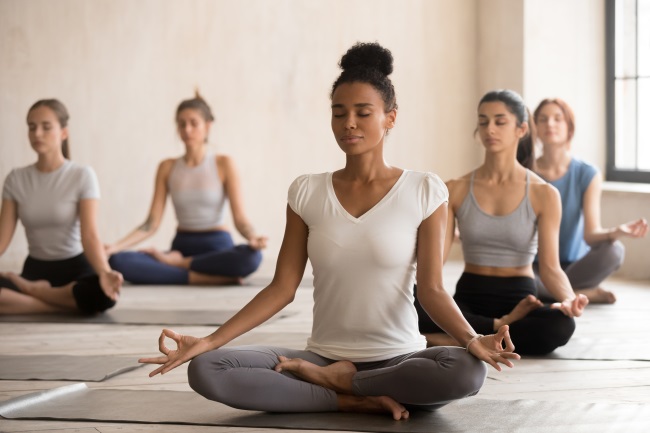In our latest learning to meditate article Chandra Devi (the chosen pen name and Hindi baptismal name of Karen Northshield) explains why a little meditation goes a long way in a busy day.
Feeling stressed out, anxious, irritable, or super busy? Then meditation is for you. You get so much more out of meditation than what your first impression might let you believe – including freeing up time to meditate. It is the best antidote to stress and headaches. Most importantly, just like going for a walk, it clears the mind – you do not need to take an Aspirin. You also do not have to stay motionless for hours like a Bodhisattva (someone seeking awakening – bodhi – on the path to becoming a buddha) or go on expensive retreats to reap the benefits.
Meditation is not only accessible, but also affordable. In this article, I will demonstrate how 10 minutes of observing one’s thoughts and breath can have remarkable effects. Incorporating this practice can be a panacea for around-the-clock workers, to manage common ills such as headaches, stress and lack of concentration. With genuine regularity it can help regularise sleep patterns and combat negative emotions.
So why not start now? To help, I list 10 useful tips to help you meditate better and turn it into a routine. The method is dubbed 10 (minutes) x 10 (days) as 10 days is usually the tipping point when adjustments start being part of your day and you see the advantages. If you miss a day, do not beat yourself up, simply continue the following day. As soon as you can, try and make the activity a habit. And 10 minutes a day follows the concept of ‘less is more’ or ‘quality versus quantity’.
You may think of meditation as a waste of time. Sitting in a lotus position or lying on the floor may give the impression of doing ‘nothing’, as the thoughts spur like leaves in a whirlwind. On a conscious level, little may seem to be happening, but on a subconscious level, so much is going on with both body, mind and beyond. In Hindu belief, meditation affects our astral or spiritual body, which can give you the feeling of elevation or empowerment
In general, when we avoid something that demands our attention, it is what we need the most… so please read these tips to turn your meditation into a habit.
Tip 1: Be curious
Be curious about how the mind works, what the body feels and where and how to improve your life. The most effective and in-the-moment thoughts happen when we are curious. Be curious about what you will learn and discover during your meditation practice. We learn the most by observing, and when meditating, we observe body and mind.
Tip 2: Pick a time and stick with it
When is the most appropriate time for your mind to meditate? For some people, it will be in the small hours, for others during a work break, queuing at the shops or on public transport. Use the 10-day method to experiment what the right time is for you.
Tip 3: Make it regular
What exercise is to the body, and washing up is to our hygiene, meditation is to our mind. You brush your teeth, shower, and exercise daily. So why would not you take care of your mind? Regularity is not the same as quantity. With anything in life, it is better to do a little each day than a lot once a week or month. You cannot just eat or sleep once and then feel replenished for the rest of your days. Just as we need to eat and sleep daily, we should also tend to the mind.
Tip 4: Create space
Space is essential for meditation. If you approach it on the gallop, you will leave it breathless and in a rush. You need to create space around your meditation time, just as you would make room on your desk or kitchen to work or cook.
 Tip 5: Follow a meditation app
Tip 5: Follow a meditation app
These tools are user-friendly as well as practical and fun. You can use them anywhere and everywhere. InsightTimer, UCL Mindful, or Petit bamboo are just a few. You can mark your progress and motivation. There are free versions and for a few euros a month you can extend your options for more variety. Apps will guide you and give you a sense that you are meditating correctly.
Tip 6: Sign up for a class and become a regular
Joining a class makes you part of a community. There is a benefit to being part of a class and in sharing the same energy with like-minded people. It allows you to engage with yourself and meet up with your meditation friends. And you may even meet your soulmate.
Tip 7: Find your mantra
Mantras are positive. Finding your mantra is like finding your favourite song and singing it when you are happy or sad. Saying or singing it like a stuck record will remind you of how unique, beautiful and human you are.
Tip 8: Practise gratitude
Gratitude starts by waking up saying ‘thank you’ to life, and going to bed affirming ‘merci’ for a day full of opportunities. For the chance to be a better person, and to improve the quality of one’s life. Repeating words of thanks for simple things changes a drab day into one of awareness and happiness. There are many things to be grateful for in life, starting by pausing and becoming aware of our surroundings.
Tip 9: Practise mindfulness
Mindfulness is the art of being conscious in the present moment. It takes place in everyday activities such as brushing your teeth, taking a shower, listening to music, going for a walk and eating. The rule is to perform one activity at a time, and one only. Use the time you have to perform an activity and connect to that activity as if your life depends on it.
Tip 10: Tune in to soft, peaceful music
Listening to music helps to elevate the frequencies of the mind and vibrations of the body Listening to soft, gentle music calms the mind, reducing the wavelengths from beta (normal state of awakeness) to alpha (relaxation).
So, take it from me, please try out this new 10x10x10 minute method, integrating one or two of the tips. Those ten minutes will really affect the rest of your 24-hour day.
Read Mindfulness coaching: Discover how to live in a healthy society
Read more learning to meditate articles…







